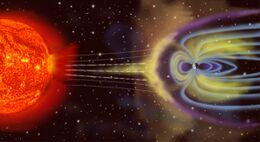Physics:May 1921 geomagnetic storm
 Artist's depiction of solar wind striking Earth's magnetosphere (size and distance not to scale) | |
| Type | Geomagnetic storm |
|---|---|
| Formed | 13 May 1921 |
| Dissipated | 15 May 1921 |
| Damage | Substantial damage to overhead and underwater telegraph equipment; electrical fires |
| Power outages | Localized electric grid interruptions |
| Areas affected | Worldwide |
Part of Solar cycle 15 | |
The three-day May 1921 geomagnetic storm, also known as the New York Railroad Storm, was caused by the impact of an extraordinarily powerful coronal mass ejection on Earth's magnetosphere. It occurred on 13–15 May as part of solar cycle 15, and was the most intense geomagnetic storm of the 20th century.[1]
Since it occurred before the extensive interconnectivity of electrical systems and the general electrical dependence of infrastructure in the developed world, its effect was restricted; however, its ground currents were up to an order of magnitude greater than those of the March 1989 geomagnetic storm which interrupted electrical service to large parts of northeastern North America.[2]
Effects
The storm's electrical current sparked a number of fires worldwide, including one near Grand Central Terminal which made it known as the "New York Railroad Storm".[1] Contemporary scientists estimated the size of the sunspot (AR1842)[1] which began on May 10—and caused the storm—as 151,000 by 34,000 km (94,000 by 21,000 miles).[3][4]
The storm was extensively reported in New York City , which was a center of telegraph activity as a railroad hub.[5] Auroras ("northern lights") appeared throughout the eastern United States , creating brightly lit night skies. Telegraph service in the U.S. first slowed and then virtually stopped at about midnight on 14 May due to blown fuses and damaged equipment.[6] Radio propagation was enhanced during the storm due to ionosphere involvement, however, enabling unusually good long-distance reception. Electric lights were not noticeably affected.[7]
Undersea telegraph cables were affected by the storm. Damage to telegraph systems was also reported in Europe[8] and the Southern Hemisphere.[9]
A paper in 2019 estimates intensity of Dst = −907±132 nT.[10]
"Dst" is the "Disturbance Storm Time index"; for comparison, for the Carrington Event superstorm of 1859 the estimated Dst was included between -850 nT (Siscoe et al., 2006) and -1050 nT (Gonzalez et al., 2011).
See also
References
Footnotes
- ↑ 1.0 1.1 1.2 Phillips, Tony (12 May 2020). "The Great Geomagnetic Storm of May 1921". https://spaceweatherarchive.com/2020/05/12/the-great-geomagnetic-storm-of-may-1921/. Retrieved 1 June 2020.
- ↑ Dr Tony Phillips (January 21, 2009). "Severe Space Weather - Social and Economic Impacts". NASA. https://science.nasa.gov/science-news/science-at-nasa/2009/21jan_severespaceweather/. Retrieved December 18, 2012.
- ↑ "Borealis Cause, Sun Spots, Will Diminish Today". Chicago Daily Tribune: p. 4. May 16, 1921. http://www.solarstorms.org/NewsPapers/1921o.pdf. Retrieved December 19, 2012.
- ↑ "Sun Spots Vanishing". The Los Angeles Times: pp. 1 & 2. May 16, 1921. http://www.solarstorms.org/NewsPapers/1921r.pdf. Retrieved December 19, 2012.
- ↑ "May 13, 1921 – The New York Railroad Storm". http://www.solarstorms.org/SS1921.html. Retrieved 31 May 2020.
- ↑ M. Hapgood (2019). "The great storm of May 1921: An exemplar of a dangerous space weather event". Space Weather 17 (7): 950–975. doi:10.1029/2019SW002195.
- ↑ "Sunspot Aurora Paralyses Wires". New York Times: pp. 1 & 3. May 15, 1921. http://www.solarstorms.org/NewsPapers/1921c.pdf. Retrieved December 19, 2012.
- ↑ "Cables Damaged by Sunspot Aurora". New York Times: pp. 1 & 4. May 17, 1921. http://www.solarstorms.org/NewsPapers/1921d.pdf. Retrieved December 19, 2012.
- ↑ "Aurora Borealis". Hawera & Normanby Star: p. 8. May 16, 1921. http://paperspast.natlib.govt.nz/cgi-bin/paperspast?a=d&d=HNS19210516.1.8&e=-------10--1----0--. Retrieved December 18, 2012.
- ↑ Jeffrey J. Love; Hisashi Hayakawa; Edward W. Cliver (2019). "Intensity and Impact of the New York Railroad Superstorm of May 1921". Space Weather 17 (8): 1281–1292. doi:10.1029/2019SW002250. Bibcode: 2019SpWea..17.1281L.
Bibliography
- The Aurora Borealis of May 14, 1921 JSTOR 40710695
- "May 13, 1921 – The New York Railroad Storm". Solarstorms.org. http://www.solarstorms.org/SS1921.html. Retrieved February 9, 2019. A bibliography of newspaper and journal articles.
- "Northern Lights Are Busy". New York Times: p. 10. May 14, 1921. http://www.solarstorms.org/NewsPapers/1921h.pdf. Retrieved December 19, 2012.
- "Aurora Borealis Halts Telegraph Service to City". The Atlanta Constitution: p. 1. May 15, 1921. http://www.solarstorms.org/NewsPapers/1921j.pdf. Retrieved December 19, 2012.
- Henry K. Bunn (May 15, 1921). "The Story The Week Has Told". The Atlanta Constitution: p. 8. http://www.solarstorms.org/NewsPapers/1921k.pdf. Retrieved December 19, 2012.
- "Tricky Aurora Snarls Up Wires". Chicago Daily Tribune: p. 1. May 15, 1921. http://www.solarstorms.org/NewsPapers/1921n.pdf. Retrieved December 19, 2012.
- "Aurora is Disturber". The Los Angeles Times: pp. 1 & 2. May 15, 1921. http://www.solarstorms.org/NewsPapers/1921p.pdf. Retrieved December 19, 2012.
- "The Aurora Borealis". The Los Angeles Times: p. 14. May 16, 1921. http://www.solarstorms.org/NewsPapers/1921s.pdf. Retrieved December 19, 2012.
- "Aurora Borealis Effect on Wires Laid to Sun Spot". The Atlanta Constitution: p. 3. May 16, 1921. http://www.solarstorms.org/NewsPapers/1921m.pdf. Retrieved December 19, 2012.
- "Sunspot Credited with Rail Tie-Up". New York Times: p. 2. May 16, 1921. http://www.solarstorms.org/NewsPapers/1921a.pdf. Retrieved December 19, 2012.
- "Magnetic Tremors Expected to Pass Within 48 Hours". New York Times: p. 1. May 16, 1921. http://www.solarstorms.org/NewsPapers/1921b.pdf. Retrieved December 19, 2012.
- "Cables Still Show Effects of Aurora". New York Times: p. 12. May 18, 1921. http://www.solarstorms.org/NewsPapers/1921e.pdf. Retrieved December 19, 2012.
- "Electric Disturbances Affect French Wires: Aurora Not Visible, Its Absence Being Attributed to Atmospheric Conditions". New York Times: p. 12. May 18, 1921. http://www.solarstorms.org/NewsPapers/1921f.pdf. Retrieved December 19, 2012.
- S.M. Silverman; E.W.Cliver (March 2001). "Low-latitude auroras: the magnetic storm of 14–15 May 1921". Journal of Atmospheric and Solar-Terrestrial Physics 63 (5): 523–525. doi:10.1016/S1364-6826(00)00174-7. Bibcode: 2001JASTP..63..523S. http://digitalcommons.unl.edu/cgi/viewcontent.cgi?article=1003&context=usafresearch&sei-redir=1&referer=http%3A%2%2Fwww.google.com.au%2Furl%3Fsa%3Dt%26rct%3Dj%26q%3Dgreat%2520geomagnetic%2520storm%2520may%25201921%26source%3Dweb%26cd%3D2%26cad%3Drja%26ved%3D0CDwQFjAB%26url%3Dhttp%253A%252F%252Fdigitalcommons.unl.edu%252Fcgi%252Fviewcontent.cgi%253Farticle%253D1003%2526context%253Dusafresearch%26ei%3DXXzQUP2tFaWhiAeZ34GYAw%26usg%3DAFQjCNHr5qruFqjcc8OXq_Piiw9fn7X9pw%26bvm%3Dbv.1355534169%2Cd.dGY#search=%22great%20geomagnetic%20storm%20may%201921%22. Retrieved December 18, 2012.

